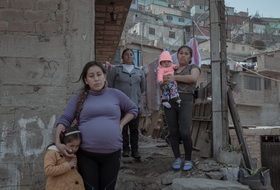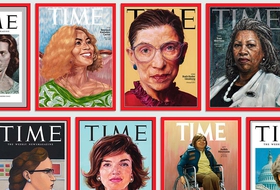
One in three women have suffered physical or sexual violence. With contributions from Europe, Africa, Asia and Latin America, we look at how this shadow pandemic affects every corner of the world.
Jo Farrell, award-winning photographer and cultural anthropologist, has been documenting the last surviving Chinese women with bound feet since 2007. Her project, Living History, was borne out of the desire to record the dying tradition and has culminated in the publication of a book featuring photographs of and interviews with women with “lotus feet”. Women
Jo Farrell, award-winning photographer and cultural anthropologist, has been documenting the last surviving Chinese women with bound feet since 2007. Her project, Living History, was borne out of the desire to record the dying tradition and has culminated in the publication of a book featuring photographs of and interviews with women with “lotus feet”. Women who, now in old age, embody a vision of femininity that is today vilified but which, in their youth, was their ticket to social mobility.
The origins of foot binding in China are traced to the 1st century. It is said that the Emperor Li Yu’s concubine bound her feet to perform a “lotus dance”. The practice involved the breaking of the feet’s bones by binding them since childhood. It was initially confined to the upper classes but gradually spread throughout social strata. Lotus feet gave even poor women the opportunity of marrying into wealth.
Farrell explains that, in “having perfectly formed small feet, women would be considered good wife material as they had endured so much and would not complain.”
The practice was outlawed in 1912 but continued until 1949. With the Communist rise to power, “anti-foot binding inspectors went to villages to forcibly remove bindings”, says the photographer. Thus the women who had had their feet bound before 1949 were to face the regime of hard manual labour imposed by the Maoist regime, finding “bound feet were a liability”. Though the women Farrell has met “did marry into relatively ‘good’ families, the majority were peasant farmers and spent most of their lives in the fields”, she points out.
Dispersed amongst the Chinese masses, these ladies are not easy to come by. Commenting on how she began her search, Farrell says: “I presumed that there were none left alive. One day I came across a driver who said his grandmother had bound feet – I travelled to her village in Shandong Province and met Zhang Yun Ying in May 2005”. From this first encounter others came about through word of mouth. To this day, Farrell has interviewed and photographed around fifty women with bound feet, five of whom have died since she first met them.
Instead of fetishising or condemning these women and their deformed feet, Farrell’s portrayal seeks to capture their humanity and grace. “I want to shed light and tell the stories of these incredible women through my photographs and words. I think people are too quick to judge another person’s culture without thinking through why something came about”. She gives the examples of plastic surgery and female genital mutilation, both forms of modification that seek to mould the body according to aesthetic standards determined by culture rather than by nature.
Though many today flinch at the sight of “lotus feet”, they were once considered the pinnacle of female beauty, as well as the ultimate erogenous zone. Farrell points out: the women “often show me how small their feet used to be before they unbound them in the late 1940s, and I believe it is with a sense of pride over what they had originally achieved”.
Farrell’s black and white photographs, produced entirely using traditional methods, inspire respect for the women they capture. She comments: “Since the beginning of the project I have had an overwhelming feeling of empathy for these women. They have been extremely courageous and their stories should be kept and told to future generations. I will be continuing this project. Every year I revisit the women and it is a very heartwarming experience”.
Siamo anche su WhatsApp. Segui il canale ufficiale LifeGate per restare aggiornata, aggiornato sulle ultime notizie e sulle nostre attività.
![]()
Quest'opera è distribuita con Licenza Creative Commons Attribuzione - Non commerciale - Non opere derivate 4.0 Internazionale.
One in three women have suffered physical or sexual violence. With contributions from Europe, Africa, Asia and Latin America, we look at how this shadow pandemic affects every corner of the world.
The Istanbul Convention against gender-based and domestic violence marks its tenth anniversary. We look at what it is, who its signatories are, and what the future might hold.
European Commission President Ursula von der Leyen reminded us of the gravity of violence against women around the world, and of the Istanbul Convention’s utmost importance.
President Erdoğan has pulled Turkey out of the Istanbul Convention, key in the fight against gender violence, claiming that it favours the LGBT community rather than family values.
Violence against women in Peru has increased as a result of Covid-19 lockdowns. 14,912 people were reported missing from January to November 2020, more than half of them minors and 64 per cent women. People have been confined to their homes for months, many forced to endure poor physical, economic and social conditions. A situation that
Joys Estefani Qqueccaño Huamani, 24, disappeared from her rural community in Peru on 9 October. Her family began looking for her independently of the authorities and despite the resistance of relatives of Joys Estefani’s ex-partner Arturo Ccana Condori, 32, charged with committing violence against her on 28 September, eleven days before Joys Estefani disappeared. Photos
Costa Rica celebrated its first same-sex marriage when two women, Alexandra Quiros and Dunia Araya, celebrated their wedding: an “extraordinary moment”.
The pandemic and its restrictions are affecting everyone, without exceptions. However factors like housing, income inequalities, gender, access to technology and working conditions are influencing how people experience the health crisis.
Time magazine’s 100 Women of the Year project sheds light on influential women’s stories, from Amelia Earhart to Greta Thunberg. A selection of some of the greats for International Women’s Day.







